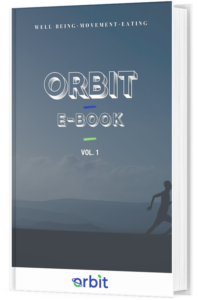Canada’s updated food guide provides a snapshot of healthy eating recommendations. Health Canada updated its food guide in 2019 and was widely recognized by dietitians and food experts to be more realistic, reader friendly, and environmentally conscious.
Here is a list of questions you may want to consider if you are looking to feel more energized after eating:
What are your eating habits?
- 3 meals a day, or do you graze on snacks throughout the day?
- What types of foods do you eat?
- Do you eat in front of a screen or at a table?
- How hungry are you before, during, or after your meal?
- Do you plan your food choices?
- How much time do you take to enjoy your food?
Are your food habits maintainable for the rest of your life?
- Does your weight change constantly?
- Do you ever feel deprived?
- Does food control your life?
- Does food prevent you from enjoying daily activities?
Recommendations for Eating Nutritiously
Firstly, make sure you have made peace with food before attempting to follow these recommendations. We, in no way, want these recommendations to become ‘food rules’. They are intended for people who, perhaps, would like to understand what food may allow them to feel more energized throughout the day. That being said, you are the sole person who can know what makes you feel good (sometimes ice cream and doughnuts is what you truly need to feel good). Taking time to feel yourself after eating or drinking something may allow you to assess what works best for you.
1. Fruits and veggies1
Vegetables and fruits offer a variety of vitamins and minerals, in addition to fibers. Eating a variety of colours, and textures of fruits and veggies everyday will allow you to meet all your vitamin and mineral needs.
Remember that juice is not a source of fruit or vegetable as most juices have a high concentration of added sugars.
Tip: Aim to eat as many colours of fruit and veggies as possible. Count how many colors you can get!
2. Staying hydrated with water 1,2
Drinking enough water is extremely important in preventing dehydration. Dehydration is not fun! It can cause diarrhea, vomiting, and can decrease your strength and aerobic exercise performances.
If you are not drinking water, you may be choosing sugary drinks, like juices, soft drinks, alcohol or others. Sugary drinks are very satisfying at times; however, they will not rehydrate you as well as water.
Tip: A good trick to know whether you are craving a sugary drink or whether you are thirsty is to drink a big glass of water before the sugary drink.
3. Whole grain foods1
Whole grain foods, such as whole grain bread, whole grain pasta, and whole grain rice have a high fiber content, which may help reduce your risk of heart diseases, colon cancer, and of strokes.
Make sure to look for products with the first ingredient being “whole grain.” Many products have “whole wheat” and “multi-grain” as their first ingredient, which do not have the same benefits as whole grains.
Tip: Some people may have stomach aches if they eat too much fiber in one day. A good rule of thumb is to eat at least one whole grain food per day.
4. Plant-based foods1,4, 5
One of the major changes in Canada’s updated food guide is that they removed milk and alternatives and meat and alternatives as stand-alone sections for protein recommendations. Both these recommendations were lumped under a general “eat protein foods” section.
Why was meat and alternatives removed as a stand-alone category? Health Canada now recommends choosing plant-based protein as much as possible as it provides more fiber, and less saturated fat than animal-derived protein. Examples of plant-based proteins are lentils, seeds, soy products, and many more.
Why was milk and alternatives removed as a stand-alone category? Despite dairy products being an important source of protein and calcium, 70 % of the world’s population have lactose intolerance. Symptoms of lactose intolerance include bloating, abdominal discomfort, and diarrhea. As people age, the number of enzymes to digest lactose decreases. This means that a large portion of our population cannot consume dairy products without experiencing discomfort.
Protein is extremely important for everybody, but especially for strength and endurance athletes! A general requirement is 1.2 to 1.4 grams of protein per kilogram (kg) of body weight for endurance athletes, and 1.6 to 2.0 grams of protein per kg of body weight for strength athletes.
Tip: Calculate the number of grams of protein you need per day and spread it out in 3 to 4 meals during the day.
5. Mindful eating 1,6
Health Canada explains that eating mindfully means that you pay attention to how, why, what, when, where, and how you eat.
Avoid being in a cycle of diets that make you gain and lose weight constantly. Diets may prevent you from eating when you are truly hungry and will deprive you from specific foods. Deprivation will only make you desire the food more, and may ultimately end in a binge eating session, feelings of guilt, and another cycle of deprivation. The research shows that people who diet will regain the weight lost, if not more, within four to five years of undertaking the diet. With this cycle of diets, some people may also acquire eating disorders such as bulimia, or binge eating disorder.
Rather than dieting, start by taking the time to eat, and take the time to think about what you want to eat. Allow eating to be an enjoyable experience that is multisensory. When eating, put aside any distractions, such as phones, books, and TV and focus on your food. Being distracted may prevent you from feeling your fullness and you may eat more than your body needs.
Tip4: Before eating, ask yourself where you are on the hunger and fullness scale (1 to 10). You will want to be at a 3 (Hungry and ready to eat) or 4 (Beginning to feel signs of hunger). Then, stop in the middle of your meal for 10 seconds and ask yourself how full you are. You will want to be at a 6 (satisfied, no longer hungry) or 7 (slightly uncomfortable feeling of fullness).

Wrap-Up
Canada’s food guide is a great resource for those looking to understand how to eat more nutritious foods in their daily life. We would also like to acknowledge that it is important to make sure peace has been made with all foods before following their recommendations. If you restrict certain foods (for non-medical reasons) we recommend you attempt to understand why you do so, and how you can foster a peaceful relationship with all foods, free of moral values. To know more about becoming an intuitive eater, click here.
There exists many trained and certified people who can help foster a peaceful relationship with food, free of rules, that allow you to accept and respect your body.
References:
1Government of Canada. (2020, January 13). Canada’s food guide. https://food-guide.canada.ca/en/
2 Coyle, E. F. (2003). Fluid and fuel intake during exercise. Journal of sport sciences, 22(1), 39-55.
5 Dietitians of Canada. (2017). Nutrition and athletic performance: Position of dietitians of Canada, the academy of nutrition and dietetics of the American college of sports medicine. desLibris Documents. www.dietitians.ca/sports.





